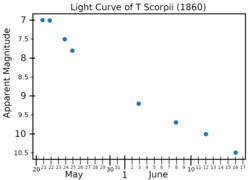Astronomy:T Scorpii
| Observation data Equinox J2000.0]] (ICRS) | |
|---|---|
| Constellation | Scorpius |
| Right ascension | 16h 17m 02.82s[1] |
| Declination | −22° 58′ 33.9″ |
| Apparent magnitude (V) | 6.8-<12.0[1] |
| Astrometry | |
| Distance | 32.6 kly (10.0 kpc)[2] ly |
| Characteristics | |
| Variable type | NA (Fast nova)[1] |
| Other designations | |
Nova Scorpii 1860, AAVSO 1611-22C[1] | |
| Database references | |
| SIMBAD | data |
T Scorpii, or Nova Scorpii 1860, was a nova in the globular cluster Messier 80 (M80). It was discovered on 21 May 1860 by Arthur von Auwers at Koenigsberg Observatory and was independently discovered by Norman Pogson on May 28 at Hartwell observatory.[4][5] It was at magnitude 7.5 at discovery, reaching a maximum of magnitude 6.8, outshining the whole cluster.[6]
T Scorpii was the first nova ever observed in any type of star cluster.[7] As of 2019 it was still the only classical nova known for certain to have occurred in a globular cluster.[8] T Scorpii faded by more than 3 magnitudes in 26 days, which means it was a "fast nova". Auwers reported that he had been observing M80 frequently since the beginning of 1859, and the nova was not visible when he observed it on 18 May 1860, 3 days before he first saw the nova. The nova was located less than 3 arc seconds from the center of M80. Astronomers recognized the significance of this object and for at least seven years after its discovery they closely monitored M80's appearance, but the star was never seen again by 19th century observers.[3]
In 1995 Shara and Drissen announced that they had identified the quiescent nova using Hubble Space Telescope images,[9] however in 2010 Dieball et al. identified a different star as the quiescent nova, based on ultraviolet and X-ray observations.[10] Subsequent publications support the Dieball et al. identification.[11][12]
References
- ↑ 1.0 1.1 1.2 1.3 "VSX: Detail for T Sco". AAVSO. http://www.aavso.org/vsx/index.php?view=detail.top&oid=32819.
- ↑ Paust, Nathaniel E. Q. et al. (February 2010), "The ACS Survey of Galactic Globular Clusters. VIII. Effects of Environment on Globular Cluster Global Mass Functions", The Astronomical Journal 139 (2): 476–491, doi:10.1088/0004-6256/139/2/476, Bibcode: 2010AJ....139..476P.
- ↑ 3.0 3.1 Sawyer, Helen B. (February 1938). "The Bright Nova of 1860 in the Globular Cluster Messier 80. and its Relation to Supernovae". Journal of the Royal Astronomical Society of Canada 32: 69. Bibcode: 1938JRASC..32...69S. https://ui.adsabs.harvard.edu/abs/1938JRASC..32...69S. Retrieved 20 December 2020.
- ↑ Auwers, A. (1886). "Aus einem Schreiben an den Herausgeber" (in de). Astronomische Nachrichten 114 (3): 47–48. doi:10.1002/asna.18861140310. Bibcode: 1886AN....114...47A. https://zenodo.org/record/1424727/files/article.pdf.
- ↑ Pogson, N. (1860). "Changes observed in the Cluster 80 Messier". Monthly Notices of the Royal Astronomical Society 21: 32–33. doi:10.1093/mnras/21.1.32. Bibcode: 1860MNRAS..21...32P.
- ↑ Stoyan, Ronald et al, Atlas of the Messier Objects, Cambridge University Press, 2008 ISBN:978-0-521-89554-5 page 275
- ↑ Wehlau, Amelia; Hogg, Helen Sawyer; Butterworth, Steve (April 1990). "Observations of Variable Stars in the Globular Cluster M80". The Astronomical Journal 99: 1159. doi:10.1086/115404. Bibcode: 1990AJ.....99.1159W. https://ui.adsabs.harvard.edu/abs/1990AJ.....99.1159W.
- ↑ Doyle, Trisha F.; Shara, Michael M.; Lessing, Alec M.; Zurek, David (March 2019). "A Hubble Space Telescope Survey for Novae in the Globular Clusters of M87". The Astrophysical Journal 874 (1): 65. doi:10.3847/1538-4357/ab0490. Bibcode: 2019ApJ...874...65D.
- ↑ Shara, Michael M.; Drissen, Laurent (July 1995). "Cataclysmic and Close Binaries in Star Clusters. III. Recovery of the Quiescent Nova 1860 a.d. (T Scorpii) in the Core of the Globular Cluster M80". The Astrophysical Journal 448: 203. doi:10.1086/175952. Bibcode: 1995ApJ...448..203S. https://ui.adsabs.harvard.edu/abs/1995ApJ...448..203S. Retrieved 20 December 2020.
- ↑ Dieball, Andrea; Long, Knox S.; Knigge, Christian; Thomson, Grace S.; Zurek, David R. (February 2010). "A Far-ultraviolet Survey of M80: X-Ray Source Counterparts, Strange Blue Stragglers, and the Recovery of Nova T Sco". The Astrophysical Journal 710 (1): 332–345. doi:10.1088/0004-637X/710/1/332. Bibcode: 2010ApJ...710..332D.
- ↑ Kopacki, G. (March 2013). "Variable Stars in the Globular Cluster M 80". Acta Astronomica 63 (1): 91–107. Bibcode: 2013AcA....63...91K. https://ui.adsabs.harvard.edu/abs/2013AcA....63...91K. Retrieved 20 December 2020.
- ↑ Göttgens, Fabian; Husser, Tim-Oliver; Kamann, Sebastian; Dreizler, Stefan; Giesers, Benjamin; Kollatschny, Wolfram; Weilbacher, Peter M.; Roth, Martin M. et al. (November 2019). "A stellar census in globular clusters with MUSE: A spectral catalogue of emission-line sources". Astronomy & Astrophysics 631: A118. doi:10.1051/0004-6361/201936485. Bibcode: 2019A&A...631A.118G.
External links
- "V* T Sco". SIMBAD. Centre de données astronomiques de Strasbourg. http://simbad.u-strasbg.fr/simbad/sim-basic?Ident=V%2A+T+Sco.
 |



